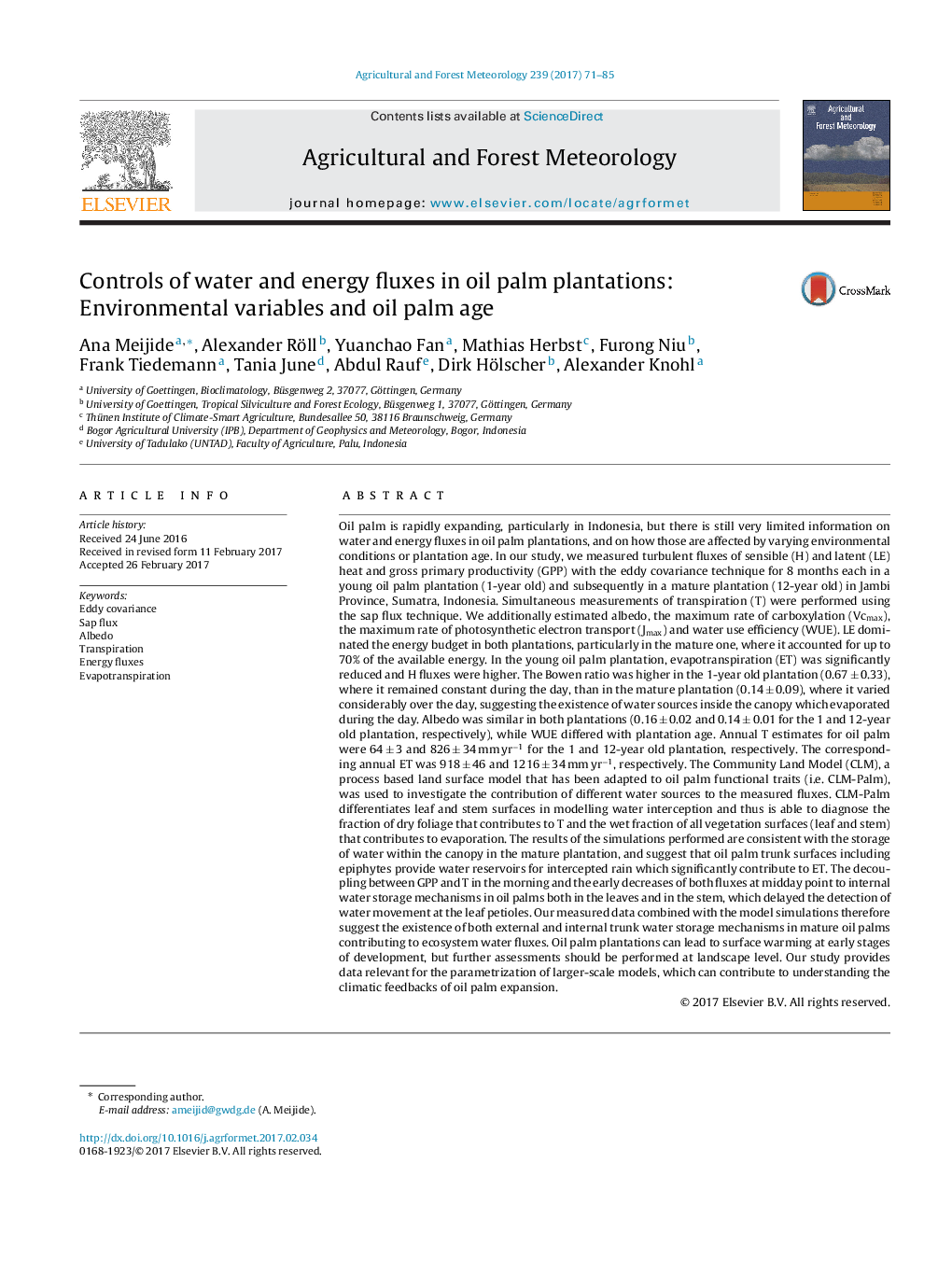| کد مقاله | کد نشریه | سال انتشار | مقاله انگلیسی | نسخه تمام متن |
|---|---|---|---|---|
| 4758926 | 1420860 | 2017 | 15 صفحه PDF | دانلود رایگان |
عنوان انگلیسی مقاله ISI
Controls of water and energy fluxes in oil palm plantations: Environmental variables and oil palm age
ترجمه فارسی عنوان
کنترل جریان آب و انرژی در مزارع نخل نخل: متغیرهای محیطی و سن نخل نخود
دانلود مقاله + سفارش ترجمه
دانلود مقاله ISI انگلیسی
رایگان برای ایرانیان
کلمات کلیدی
موضوعات مرتبط
مهندسی و علوم پایه
علوم زمین و سیارات
علم هواشناسی
چکیده انگلیسی
Oil palm is rapidly expanding, particularly in Indonesia, but there is still very limited information on water and energy fluxes in oil palm plantations, and on how those are affected by varying environmental conditions or plantation age. In our study, we measured turbulent fluxes of sensible (H) and latent (LE) heat and gross primary productivity (GPP) with the eddy covariance technique for 8 months each in a young oil palm plantation (1-year old) and subsequently in a mature plantation (12-year old) in Jambi Province, Sumatra, Indonesia. Simultaneous measurements of transpiration (T) were performed using the sap flux technique. We additionally estimated albedo, the maximum rate of carboxylation (Vcmax), the maximum rate of photosynthetic electron transport (Jmax) and water use efficiency (WUE). LE dominated the energy budget in both plantations, particularly in the mature one, where it accounted for up to 70% of the available energy. In the young oil palm plantation, evapotranspiration (ET) was significantly reduced and H fluxes were higher. The Bowen ratio was higher in the 1-year old plantation (0.67 ± 0.33), where it remained constant during the day, than in the mature plantation (0.14 ± 0.09), where it varied considerably over the day, suggesting the existence of water sources inside the canopy which evaporated during the day. Albedo was similar in both plantations (0.16 ± 0.02 and 0.14 ± 0.01 for the 1 and 12-year old plantation, respectively), while WUE differed with plantation age. Annual T estimates for oil palm were 64 ± 3 and 826 ± 34 mm yrâ1 for the 1 and 12-year old plantation, respectively. The corresponding annual ET was 918 ± 46 and 1216 ± 34 mm yrâ1, respectively. The Community Land Model (CLM), a process based land surface model that has been adapted to oil palm functional traits (i.e. CLM-Palm), was used to investigate the contribution of different water sources to the measured fluxes. CLM-Palm differentiates leaf and stem surfaces in modelling water interception and thus is able to diagnose the fraction of dry foliage that contributes to T and the wet fraction of all vegetation surfaces (leaf and stem) that contributes to evaporation. The results of the simulations performed are consistent with the storage of water within the canopy in the mature plantation, and suggest that oil palm trunk surfaces including epiphytes provide water reservoirs for intercepted rain which significantly contribute to ET. The decoupling between GPP and T in the morning and the early decreases of both fluxes at midday point to internal water storage mechanisms in oil palms both in the leaves and in the stem, which delayed the detection of water movement at the leaf petioles. Our measured data combined with the model simulations therefore suggest the existence of both external and internal trunk water storage mechanisms in mature oil palms contributing to ecosystem water fluxes. Oil palm plantations can lead to surface warming at early stages of development, but further assessments should be performed at landscape level. Our study provides data relevant for the parametrization of larger-scale models, which can contribute to understanding the climatic feedbacks of oil palm expansion.
ناشر
Database: Elsevier - ScienceDirect (ساینس دایرکت)
Journal: Agricultural and Forest Meteorology - Volume 239, 28 May 2017, Pages 71-85
Journal: Agricultural and Forest Meteorology - Volume 239, 28 May 2017, Pages 71-85
نویسندگان
Ana Meijide, Alexander Röll, Yuanchao Fan, Mathias Herbst, Furong Niu, Frank Tiedemann, Tania June, Abdul Rauf, Dirk Hölscher, Alexander Knohl,
